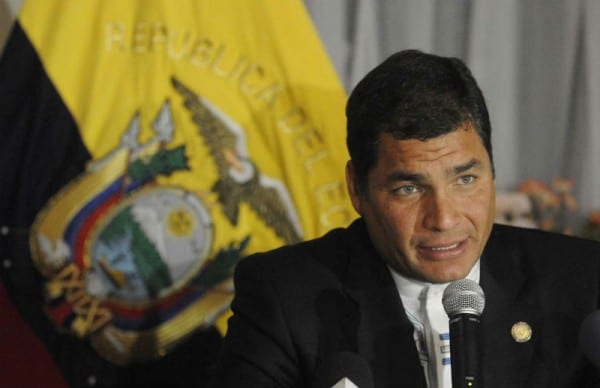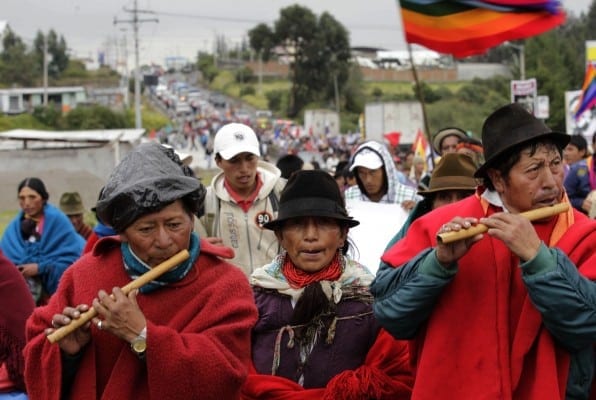[dropcap]M[/dropcap]ulti-colored ponchos, lime green government banners, and gray and olive police armor have filled the streets of Quito and other cities in Ecuador this month. Ecuadorian president Rafael Correa and opposition protestors have been engaged in a war of words and displays of physical presence in public spaces since the major nonviolent challengers, the Confederation of Indigenous Nationalities of Ecuador (CONAIE), and its allies launched a nationwide strike and march on August 13. Correa is one of the cohort of presidents challenging U.S. hegemony in Latin America, and he has taken over the leading role in promoting regional integration and denouncing U.S. intervention after Hugo Chavez’s death. For this reason the protests, and Correa’s increasingly repressive response to them, will be carefully watched by those in other countries wishing to gauge whether the ‘Bolivarian moment’ has peaked.
The widespread dissatisfaction with the Ecuadorian government masks several distinct factions within the opposition coalition. Indigenous groups and environmentalists, which initially supported Correa’s ‘Citizen Revolution’, are critical of his pursuit of mining and petroleum projects, and of the government’s heavy-handed treatment of protestors. Unions oppose labor code changes. Bankers and the urban middle class have rejected proposed legislation to increase inheritance taxes and capital gains taxes for wealthier citizens. A growing chorus of dissenters has denounced the government’s proposed constitutional amendments, especially the elimination of presidential term limits without a popular referendum. This last grievance represents the closest thing to a unifying complaint, since each faction, regardless of why it is upset, is worried about the prospect of Correa’s administration continuing indefinitely.
Since coming to office in 2007, President Correa has sought to diversify the economy beyond oil and agriculture, investing heavily in mining and hydroelectricity. He has funded major infrastructure projects and investments in education by renegotiating petroleum contracts during a time of high oil prices, increasing state capacity to collect taxes in a country where tax evasion was historically a practiced art, and by taking on debt from China in exchange for future oil supplies and profits. As state revenues have plummeted in the face of declining oil prices, however, cost-cutting measures and proposals for new revenue streams (i.e. taxes and extractive industry contracts) have eroded Correa’s remarkably durable high approval ratings to alow of 45%. The country’s political stability is more at risk than at any time in Correa’s eight-year time in office, with the possible exception of the abortive 2010 coup attempt by police.
[dropcap]D[/dropcap]espite passing a unique Constitution that gave legal standing and rights to nature and recognized indigenous rights to sumak kawsay, or good living, the government has jailed indigenous protestors, and has sent armed police to facilitate mining extraction. CONAIE says it is the combination of the government’s turnaround on extractive industries and anti-democratic repression of free speech and protest that are the most important driving forces behind the national strike and march.Protest leaders have tried to maintain a consistent message that they are targeting the government’s policies, and are not trying to topple the regime itself: CONAIE president Jorge Herrera said, “The goal is not to remove President Correa, but to change the political structure of the country.” As the violence and chaos have escalated, however, dozens of indigenous activists as well as police have been injured and hospitalized, with more than 30 protesters arrested. Street chants ofOut Correa, out! have become increasingly common. The government has labeled the opposition movement “coup plotters” and accused them of being manipulated by his right-wing political opponents, often resorting to racist portrayals of indigenous protestors as misguided pawns of traditional politicians.
The indigenous uprising, and the broader political dissention surrounding it, represents a watermark political test for Correa. His ability to overcome his personal shortcomings is likely to be the biggest factor determining if he can weather the storm. If he drops his bid to eliminate term limits without a referendum, and shows clearly by holding violators accountable that his government will not engage in arbitrary arrests or repression of peaceful protesters, the opposition is unlikely to be able to maintain a cohesive coalition given the fractured and competing interests in play. Correa still has a (quickly diminishing) chance to solidify his legacy as a progressive technocratic reformer who has improved Ecuador’s stability and reduced inequality. If he continues his past record of bullying and intolerance of dissent, and persists with the violent repression that is sending his legitimacy into a tailspin, however, he will further strengthen the elements of the opposition that want him to join so many Ecuadorian presidents before him who have been toppled through mass street protests. International pressure is needed to convince him that the stakes of trampling democracy to repress protest are more serious than just a damaged ego.




